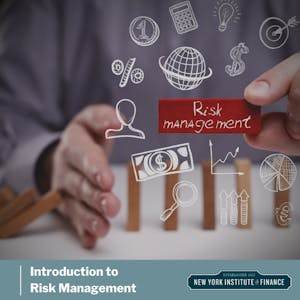Introduction to Risk Management
What is risk? Why do firms manage risk? In this course, you will be introduced to the different types of business and financial risks, their sources, and best practice methods for measuring risk. This course will help you gauge different risk types and set risk limits, describe the key factors that drive each type of risk, and identify the steps needed to choose probability distributions to estimate risk. You will explore the history and development of risk management as a science, and financial and business trends that have shaped the practice of risk management. By the end of the course, you will have the essential knowledge to measure, assess, and manage risk in your organization. To be successful in this course, you should have a basic knowledge of statistics and probability and familiarity with financial instruments (stocks, bonds, foreign exchange, etc). Experience with MS Excel recommended.
Differentiate between financial and business risks
Examine the key concepts and factors of risk measurement
Understand the application of risk modeling
Understand the principles of risk management
Syllabus
Syllabus - What you will learn from this course
Week 1
Getting Started
Week 2
Module 01: Overview of Risk Management
This course will introduce you to different types of business and financial risk. You will learn how these risks are measured and also gain an understanding of the goals and benefits of risk management. The skills that you will gain by the end of this course will enable you to measure and manage risk in your organization.
Week 3
Module 02: Types of Business and Financial Risks
In this module, you will learn about financial and business risks. You will also get introduced to the various types of financial risks and learn about their sources and how firms manage risks. We’ll also look at the difference between risk measurement and risk management. Let’s get started.
Week 4
Module 03: Money & Capital Markets and Regulatory
In this module, you will learn about the four main types of financial risk. You will then learn about the best measures to use to gauge different risk types and set risk limits. You will also learn how investment managers maximize portfolio returns while keeping risk within their tolerances and then apply these techniques to a portfolio you will construct.
Week 5
Module 04: Introduction to Risk Modeling
In this module, you will learn the difference between Money and Capital markets. You will also learn to differentiate among the 3 regulatory structures - US, UK, and EU and understand how regulatory structures impact your firm.
Week 6
End of Course
FAQ
When will I have access to the lectures and assignments?
Access to lectures and assignments depends on your type of enrollment. If you take a course in audit mode, you will be able to see most course materials for free. To access graded assignments and to earn a Certificate, you will need to purchase the Certificate experience, during or after your audit. If you don't see the audit option:
What will I get if I subscribe to this Specialization?
When you enroll in the course, you get access to all of the courses in the Specialization, and you earn a certificate when you complete the work. Your electronic Certificate will be added to your Accomplishments page - from there, you can print your Certificate or add it to your LinkedIn profile. If you only want to read and view the course content, you can audit the course for free.
Is financial aid available?
Yes. In select learning programs, you can apply for financial aid or a scholarship if you can’t afford the enrollment fee. If fin aid or scholarship is available for your learning program selection, you’ll find a link to apply on the description page.
Reviews
A good comprehensive overview to the discipline of risk management.
The course contents were great and up to date. They are relevant. Thank you.
